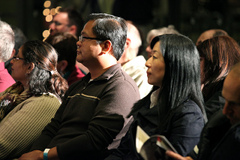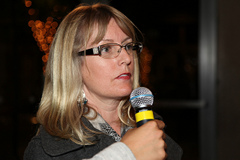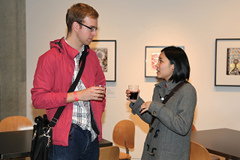
Journalist Doug Saunders opened his discussion of what he has termed “arrival cities” with a mention of the American city that best epitomizes the phenomenon: Los Angeles.
“I lived here until nine years ago, so it’s interesting to see how the city’s changed,” said Saunders, the European bureau chief and award-winning columnist for Toronto’s Globe and Mail. “I spoke to one sociologist who said that Los Angeles flushes out half its populations every 10 years.”
Saunders described arrival cities as “the lowest forms of urban living,” the crowded areas at the edges of urban areas that are often labeled “slums” or “shantytowns.” Those neighborhoods are the subject of his new book, Arrival City: The Final Migration and Our Next World.
Revolution from Arrival City
 Bulaq al-Dakrour, a neighborhood on the outskirts of Cairo, is a classic arrival city, Saunders said.
Bulaq al-Dakrour, a neighborhood on the outskirts of Cairo, is a classic arrival city, Saunders said.
“Until the mid-70s it was not much of anything, a patch of wasteland,” he said. “And then it very quickly filled up” with tin-roofed shacks and residents moving from rural areas of the country in search of better opportunities. Most middle- and upper-class denizens of Cairo avoid Bulaq al-Dakrour, but some know it as the place to get their car fixed for very little money.
“The improvised economy has grown very large within this very medievally-structured slum,” Saunders said.
Yet despite the success that many Bulaq al-Dakrour residents find by providing such needed services, they are still kept down by physical and bureaucratic factors. The canals that wind through the slum do not have bridges, isolating dwellers from central Cairo. And the government’s generally hostile attitude toward the less-attractive parts of the city have led to ill-advised attempts to either bulldoze the neighborhood or forcibly move residents further away from downtown.
Saunders cites such frustrations as a major reason that young Bulaq al-Dakrour dwellers became many of the first people to demonstrate against then-President Hosni al-Mubarak on Tahrir Square earlier this year.
The History of the Slums
 Saunders emphasized that arrival cities are not a new phenomenon: he illustrated the theme with an example about the Faubourg Saint-Antoine slum in Paris in the late 18th century. Arrival cities, he argued, were the “dominant neighborhood” in all major European cities.
Saunders emphasized that arrival cities are not a new phenomenon: he illustrated the theme with an example about the Faubourg Saint-Antoine slum in Paris in the late 18th century. Arrival cities, he argued, were the “dominant neighborhood” in all major European cities.
In 1789, a revolt against a factory owner in Faubourg Saint-Antoine created a riot that led to dozens of deaths. Similar conflicts erupted throughout Europe, including in several cities at once in 1848. The protests and resulting violence that year “was almost always centered in arrival city neighborhoods,” Saunders said.
As a result, Europe began to invest in infrastructure improvements to help the urban slums. Since then, he said, European arrival cities have thrived despite still being home to the poorest urban residents.
The Growing Role of Arrival Cities
Since that 19th-century violence, arrival cities have only become more common as the struggles of rural agrarian families in North and South America, Asia, Africa and Europe drove poor families toward cities.
“It is more often rural changes, rather than urban economies, that creates arrival cities,” Saunders said.
After World War II, nearly three-quarters of the world’s populations lived in small farming communities. By 2015, more than 60 percent of humans are expected to live in urban areas. By 2050, that number is expected to reach 70 percent.
“South America is nearly as urban now as North America and Europe, which explains the 10 or 15 years of relative stability and peace there,” he said. “The problems are not state-threatening.”
Asia’s and Africa’s populations have been slower to urbanize – about 40 percent of people on each continent live in cities – but that, too, is changing rapidly, Saunders said. As an extreme example, he mentioned Istanbul’s growth. The city was home to about 900,000 people in 1960, he said, compared with about 14 million today.
An Opportunity, Not a Problem
 As the world becomes an amalgamation of arrival cities, Saunders said, policymakers need to change the way they think about the areas often denounced for “bringing down” the city. He used the example of Slotervaart, a neighborhood made up primarily of Moroccan and Turkish immigrants in Amsterdam, to show how governments can change their attitudes toward arrival cities.
As the world becomes an amalgamation of arrival cities, Saunders said, policymakers need to change the way they think about the areas often denounced for “bringing down” the city. He used the example of Slotervaart, a neighborhood made up primarily of Moroccan and Turkish immigrants in Amsterdam, to show how governments can change their attitudes toward arrival cities.
Because of physical attributes literally keeping residents confined to Slotervaart, discontent brewed among residents. For most of the neighborhood’s existence it was “far easier to link yourself by television signals to north Africa than it was to central Amsterdam two kilometers away,” he said.
One result of this isolation was a young Muslim man from Slotervaart who stabbed filmmaker Theo van Gogh to death in 2004, which in turn “set into course a half decade of political reaction,” Saunders said.
Since then, the government of Amsterdam has taken steps to improve Slotervaart, constructing large apartment buildings that have retail space for local shopkeepers on the ground floor and removing some of the impediments to travel.
Saunders offered three categories of barriers to upward mobility from arrival cities: the physical, like the canals in Bulaq al-Dakrour; the bureaucratic that are the result of poor policy decisions; and the citizenship issues in slums that have many immigrants. If governments can remove those barriers without raising property values dramatically, he said, arrival cities can pose fantastic opportunities for nations.
“They are built upon a set of people who have made large investments and taken very large risks” and are willing to work hard to be successful, he said. “They are the places where the story of the 21st century will be told.”
For event photos, please click here.
For full video, please click here.
For an excerpt from Arrival Cities, please click here.
Buy the book: Skylight Books, Powell’s, Amazon
*Photos by Aaron Salcido.




Send A Letter To the Editors